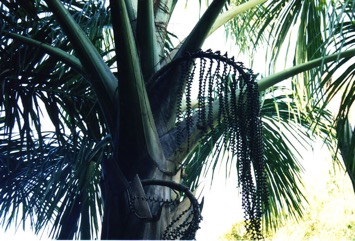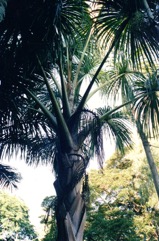Tree of Life, Buriti Nut

A tropical plant. It grows in tropical regions. It suits the hot, humid tropical lowlands. It grows in large colonies in areas subject to periodic flooding. In Bolivia it grows up to 300 m altitude and occasionally to 400m. It can grow in acid soils. In Cairns Botanical Gardens. In Townsville palmetum. It suits hardiness zones 11-12.
Also known as:
Achu, Aguaje, Boriti, Bority, Burati, Canangucho, Carandai-guazu, Caranday-guazu, Coqueiro-buriti, Guaish, Haukuaharu, Ita Palm, Ite palm, Mauriti palm, Mirisi, Miriti, Morete, Moriche, Morichi, Muricky, Muriti, Murity palm, Ohi arau, Ohidu, Palma real, Palmeira-buriti
Synonyms
- Mauritia flexuosa var. venezuelana Steyerm.
- Mauritia minor Burret
- Mauritia setigera Griseb. & H. Wendl.
- Mauritia sphaerocarpa Burret
- Mauritia vinifera Mart.
- Saguerus vinifera Mart.
Edible Portion
- Fruit, Nuts, Stem-starch, Sap, Palm heart, Oil, Sago, Cabbage, Flower
Where does Tree of Life grow?
Found in: Amazon, Australia, Bolivia, Brazil, Central America, Colombia, Ecuador, French Guiana, Guianas, Guyana, Panama, Peru, South America, Suriname, Trinidad and Tobago, Venezuela
Notes: There are 2 Mauritia species. The fruit have 30-300 mg carotene per 100 g of pulp, which is equivalent to 50,000-500,000 IU of provitamin A. The mesocarp contains 5.2% protein. It has antioxidant properties and is rich in Vitamin A.
Status: The fruit is an important part of the diet in the Amazon.
Growing Tree of Life, Buriti Nut
Cultivation: Plants are grown from seed. Seed germinate erratically. Seeds take 2-6 months to germinate. The fresh fruit can be used directly as seeds. Seeds are only viable for a short time.
Edible Uses: The fruit are eaten. The fruit are soaked in water to soften the outer layer which is then scraped off and the layer around the seed is eaten. They are also dried and converted into flour. The fruit are eaten cooked. The fruit are used for wine. The fruit yield an edible oil. The oily pulp of the fruit is boiled with sugar and made into a sweetmeat. The juice of the stem is used for a drink. The sap from the cut flower stalk is collected and used for wine. The trunk pith contains a starch similar to sago.
Production: Plants only develop slowly. The fruit contain 8-9% edible oil.
Nutrition Info
per 100g edible portion| Edible Part | Energy (kcal) | Protein (g) | Iron (mg) | Vitamin A (ug) | Vitamin c (mg) | Zinc (mg) | % Water |
|---|---|---|---|---|---|---|---|
| Fruit | 143 | 1.1 | 3.5 | - | 56.7 | - | 72.8 |
| Fruit | 219 | 2.3 | 1.8 | - | 56.8 | 0.6 | 57 |
Tree of Life, Buriti Nut Photos


References
Abadio Finco, F. D. B. et al, 2012, Physicochemical characteristics and Antioxidant activity of three native fruit from Brazilian savannah (Cerrado). Alim. Nutr. Araraquara, v 23, n. 2 pp 179-185
Bailao, E. F. L. C., et al, 2015, Bioactive Compounds Found in Brazilian Cerrado Fruits. International Journal of Molecular Sciences. 16:23760-23783
Balick, M.J. and Beck, H.T., (Ed.), 1990, Useful palms of the World. A Synoptic Bibliography. Colombia p 54, 63, 68, 90, 121, 157, 223 (As Mauritia minor), 278, 309, 435, 444 (As Mauritia vinifera), 558, 611,
Bortolotto, I. M., et al, 2018, Lista preliminar das plantas alimenticias nativas de Mato Grosso do Sul, Brasil. Iheringia, Serie Botanica, Porto Alegre, 73 (supl.):101-116
Brazil: Biodiversity for Food and Nutrition. http://www.b4fn.org/countries/brazil/
Etkin, N. L. (Ed.), 1994, Eating on the Wild Side, Univ. of Arizona. p 139, 157
Etherington, K., & Imwold, D., (Eds), 2001, Botanica's Trees & Shrubs. The illustrated A-Z of over 8500 trees and shrubs. Random House, Australia. p 470
Eynden, Van den, V., & Cueva E., Cabrera, O., 2004, Edible Palms of Southern Ecuador. Palms. Vol 48(3):141-147
Facciola, S., 1998, Cornucopia 2: a Source Book of Edible Plants. Kampong Publications, p 29
Fagg, C. W. et al, 2015, Useful Brazilian plants listed in the manuscripts and publications of the Scottish medic and naturalist George Gardner (1812–1849). Journal of Ethnopharmacology 161 (2015) 18–29
Gibbons, M., 2003, A pocket guide to Palms. Chartwell Books. p 144
Grandtner, M. M. & Chevrette, J., 2013, Dictionary of Trees, Volume 2: South America: Nomenclature, Taxonomy and Ecology. Academic Press p 388
Haynes, J., & McLaughlin, J., 2000, Edible palms and Their Uses. University of Florida Fact sheet MCDE-00-50-1 p 10
Hedrick, U.P., 1919, (Ed.), Sturtevant's edible plants of the world. p 406
Hedrick, U.P., 1919, (Ed.), Sturtevant's edible plants of the world. p 406 (As Mauritia vinifera)
Henderson, A., Galeano, G and Bernal, R., 1995, Field Guide to the Palms of the Americas. Princeton. p 69
Hunter, D., et al, 2019, The potential of neglected and underutilized species for improving diets and nutrition. Planta (2019) 250:709-729
Janick, J. & Paul, R. E. (Eds.), 2008, The Encyclopedia of Fruit & Nuts. CABI p 132
Johnson, D.V., 1998, Tropical palms. Non-wood Forest products 10. FAO Rome. p 20, 93, 122, 133
Johnson, M. and Colquhoun, A., 1996, Preliminary Ethnobotanical Survey of Kurupukari: An Amerindian Settlement of Central Guyana. Economic Botany, Vol. 50, No. 2, pp. 182-194
Jones, D.L., 1994, Palms throughout the World. Smithtonian Institution, Washington. p 51, 52, 55
Jones, D.L., 2000, Palms of Australia 3rd edition. Reed/New Holland. p 182
Kuhnlein, H. V., et al, 2009, Indigenous Peoples' food systems. FAO Rome p 83
Lorenzi, H., 2002, Brazilian Trees. A Guide to the Identification and Cultivation of Brazilian Native Trees. Vol. 01 Nova Odessa, SP, Instituto Plantarum p 297
Lorenzi, H., Bacher, L., Lacerda, M. & Sartori, S., 2006, Brazilian Fruits & Cultivated Exotics. Sao Paulo, Instituto Plantarum de Estuados da Flora Ltda. p 82
Maas, P.J. M., Non-Timber Forest Products of the North-West District of Guyana Part 2. The 85 most important NTFP species. p 156
Macmillan, H.F. (Revised Barlow, H.S., et al) 1991, Tropical Planting and Gardening. Sixth edition. Malayan Nature Society. Kuala Lumpur. p 303
Marcia, M. J., et al, 2011, Palm Uses in Northwestern South America: A Quantitative Review. Bot. Rev. (2011) 77:462-570
Melnyk, M., Indigenous enterprise for the domestication of trees and the commercialization of their fruits. FAO
Martin, F. W., et al, 1987, Perennial Edible Fruits of the Tropics. USDA Handbook 642 p 47
Menninger, E.A., 1977, Edible Nuts of the World. Horticultural Books. Florida p 138
Oliviera V. B., et al, 2012, Native foods from Brazilian biodiversity as a source of bioactive compounds. Food Research International 48 (2012) 170-179 (As Mauritia vinifera)
Omawale, 1973, Guyana's edible plants. Guyana University, Georgetown p 25
Paz, F. S., et al, 2021, Edible Fruit Plant Species in the Amazon Forest Rely Mostly on Bees and Beetles as Pollinators. Journal of Economic Entomology, XX(XX), 2021, 1–13
Philips, O., 1992, The potential for harvesting fruits in tropical rainforests: new data from Amazonian Peru. Biodiversity and Conservation 2, 18-38
Riffle, R.L. & Craft, P., 2003, An Encyclopedia of Cultivated Palms. Timber Press. p 385
Smith, N., Mori, S.A., et al, 2004, Flowering Plants of the Neotropics. Princeton. Plate 55 (Photo)
Smith, N., et al, 2007, Amazon River Fruits. Flavors for Conservation. Missouri Botanical Gardens Press. p 70
Suppl. pl. 454. 1782 ("1781")
USDA, ARS, National Genetic Resources Program. Germplasm Resources Information Network - (GRIN). [Online Database] National Germplasm Resources Laboratory, Beltsville, Maryland. Available: www.ars-grin.gov/cgi-bin/npgs/html/econ.pl (10 April 2000)
Vael, L., 2015, Ethnobotanical study of the plant use in the natural landscape of two mestizo communities in the Ucayali region of the Peruvian Amazon. Universiteit Gent.
Van den Eynden, V., et al, 2003, Wild Foods from South Ecuador. Economic Botany 57(4): 576-603
Van den Eynden, V. et al, 2004, Edible Palms of Southern Ecuador. Palms Volume 48(3):142-148
van Roosmalen, M.G.M., 1985, Fruits of the Guianan Flora. Utrecht Univ. & Wageningen Univ. p 352
Vasquez, R. and Gentry, A. H., 1989, Use and Misuse of Forest-harvested Fruits in the Iquitos Area. Conservation Biology 3(4): 350f
Vasquez, Roberto Ch. & Coimbra, German S., 1996, Frutas Silvestres Comestibles de Santa Cruz. p 168
Villachica, H., (Ed.), 1996, Frutales Y hortalizas promisorios de la Amazonia. FAO, Lima. p 4
Wickens, G.E., 1995, Edible Nuts. FAO Non-wood forest products. FAO, Rome. p168
World Checklist of Useful Plant Species 2020. Royal Botanic Gardens, Kew
Zambrana, P, et al, 2017, Traditional knowledge hiding in plain sight – twenty-first century ethnobotany of the Chácobo in Beni, Bolivia. Journal of Ethnobiology and Ethnomedicine (2017) 13:57